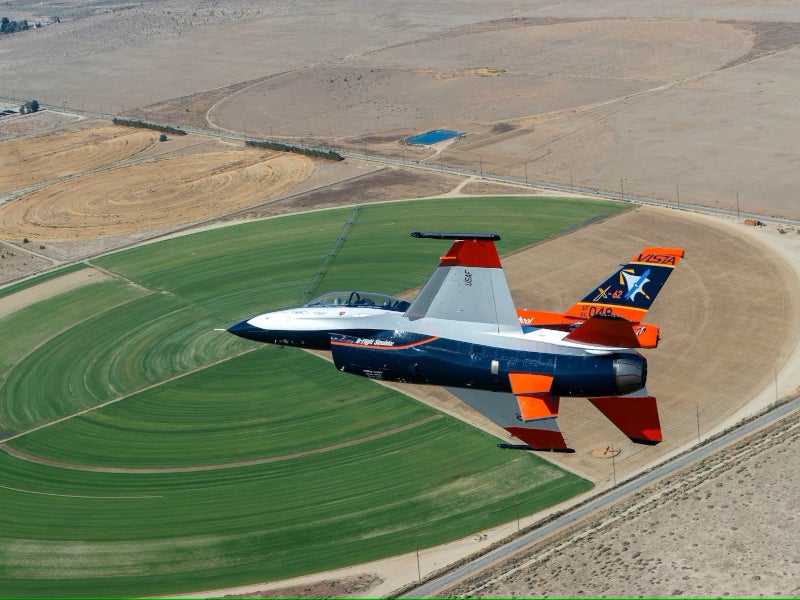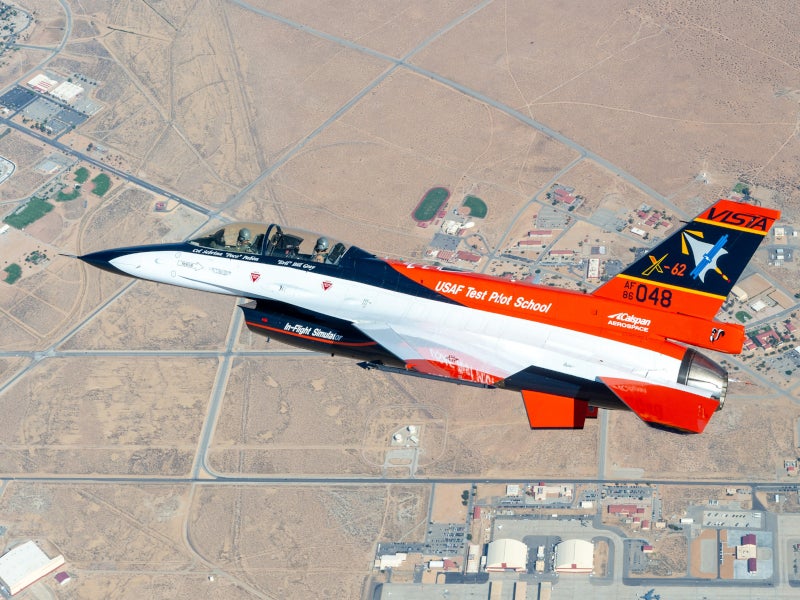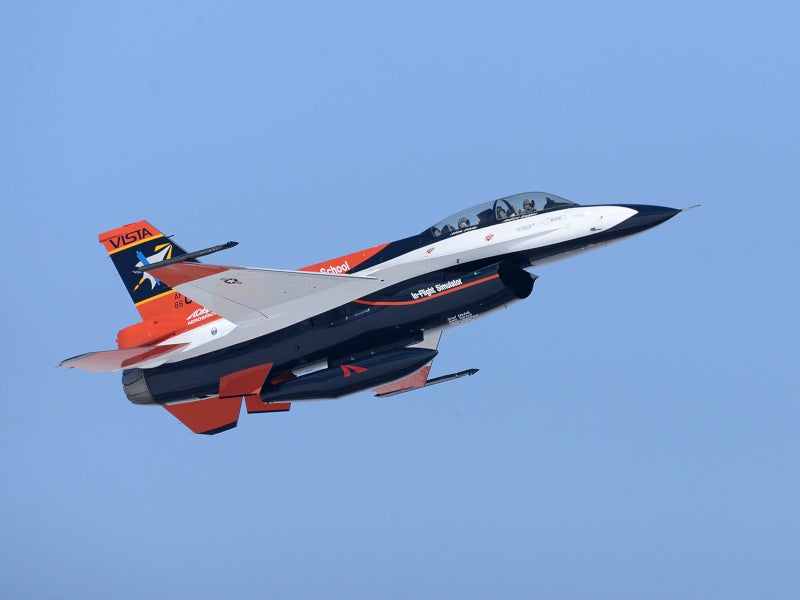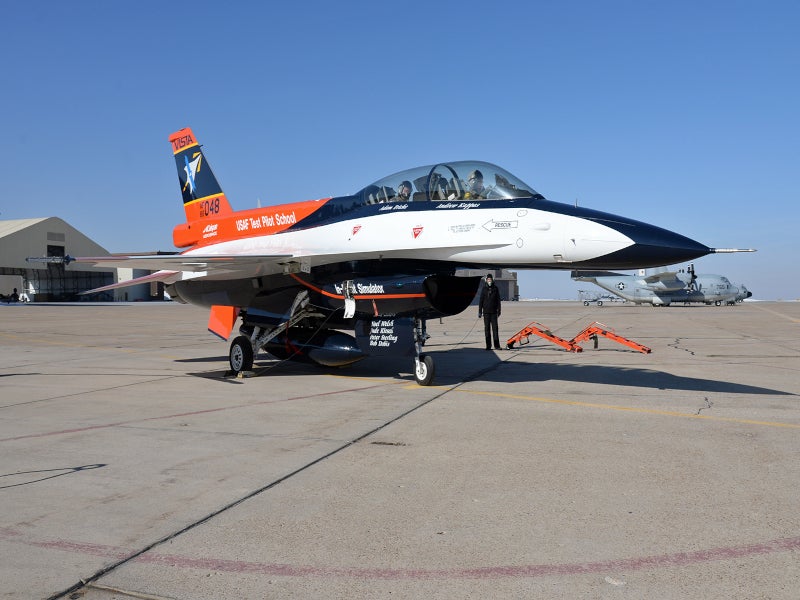Variable In-flight Simulation Test Aircraft (VISTA) X-62A, previously designated NF-16D, is a one-of-a-kind training aircraft manufactured by Lockheed Martin Skunk Works® together with Calspan for the United States Air Force Test Pilot School (USAF TPS) at Edwards Air Force Base (Edwards AFB) in California, US.
The aircraft will play a key part in the acceleration of the development of artificial intelligence (AI) and tactical autonomy capabilities for the USAF.
The VISTA aircraft, which is a main part of the TPS curriculum, performed its maiden flight in April 1992. It underwent several upgrades and modifications over the years to address its limitations and improve the USAF’s capability to rapidly and safely test diverse types of configurations of radical nature.
In June 2021, the improved aircraft was officially redesignated from NF-16D VISTA to VISTA X-62A and regarded as a national asset by the USAF. The aircraft makes USAF TPS the only test pilot school having an operational X plane to support its curriculum.
VISTA X-62A flight testing details
The VISTA was flown by an AI-driven autonomy agent for more than 17 hours, which marked the first time AI was used to operate a tactical aircraft. The test flight was part of 12 flight tests conducted by a joint team of the US Department of Defence (DoD) to carry out advanced fighter manoeuvres at the Edwards AFB in December 2022.
The flight tests were supported by organisations such as the Air Force Research Laboratory (AFRL), the US Air Force Test Center, and Defense Advanced Research Projects Agency (DARPA).
The AI-driven autonomy agents of AFRL’s Autonomous Air Combat Operations (AACO) and DARPA’s Air Combat Evolution (ACE) piloted the VISTA X-62A for the exercises. AACO’s AI agents performed one-on-one beyond-visual-range (BVR), simulated enemy engagements, while ACE’s AI agents conducted dogfighting exercises, against constructive AI red-team agents.
The tactical manoeuvres were performed autonomously, while respecting the airspace boundaries of the real world.
VISTA X-62A training aircraft specifications
The modified VISTA X-62A aircraft has a length of 48ft 7in (14.8m), a height of 15ft 9in (4.8m), and a wingspan of 32ft 2in (9.8m). The aircraft uses National Advisory Committee for Aeronautics (NACA) 64A204 airfoils at root and tip sections of the wings.
It can fly with a maximum take-off weight of 42,300lb (19,187kg) and can carry two crew members, including a pilot and a safety pilot. The gross weight of the aircraft is 26,463lb (12,003kg), while the empty weight is 18,238lb (8,273kg).
Key features of VISTA X-62 experimental aircraft
VISTA is a modified version of the F-16D Block 30 Peace Marble Il aircraft that is fitted with Block 40 avionics. It allows the flight-testing of digital aircraft designs before the construction of the aircraft.
The aircraft has been upgraded with Calspan’s VISTA Simulation System (VSS), Lockheed Martin’s Model Following Algorithm (MFA) and System for Autonomous Control of the Simulation (SACS). VSS allows the aircraft to mimic the characteristics of different aircraft, including fixed-wing vehicles such as MQ-20 or F-16. The integration of SACS and MFA systems enables the aircraft to be used for performing the most advanced flight test experiments focused on autonomy and AI.
The X-62’s safety sandbox allows for the integration and flight of control laws and autonomy capabilities and new air vehicle designs.
SACS system details
The SACS system features the Skunk Works Enterprise-wide Open Systems Architecture (E-OSA), which powers the Enterprise Mission Computer version 2 (EMC2), also called Einstein Box.
Other components of the SACS system include advanced sensors, a multi-level security solution, and a set of Getac tablet displays in both cockpits. The components enable quick enhancements to software so that an increased number of flight tests can be performed, accelerating AI and autonomy development to meet the urgent requirements of national security.
Performance and engine details
VISTA X-62A training aircraft is equipped with a General Electric F110-GE-100 afterburning turbofan, which provides a dry thrust of 16,600lbf (74kN), and a maximum thrust of 28,200lbf (125kN) with the use of an afterburner.
The aircraft has a maximum ferry range of 2,800nm (5,200km) with three additional fuel tanks, each with a fuel carrying capacity of 370 gallons (1,401l). It can travel at a maximum speed of up to 1,170kt (2,170km/h), which increases to more than Mach 2 (2,469km/h) at altitude. The aircraft can reach speeds of Mach 1.2 (1,460km/h) at sea level.
VISTA X-62A can operate at an altitude of more than 50,000ft (15,000m) with a rate of climb of 50,000ft/min (250m/s).
Testing for Skyborg programme
The VISTA aircraft is one of the four aircraft used to support autonomy testing for the AFRL’s Skyborg programme, which is an AI-driven project to develop unmanned combat aerial vehicles that will fly alongside manned fighter aircraft.
The other three platforms used for the Skyborg programme testing are UTAP-22 Mako, Kratos XQ-58A Valkyrie, and MQ-20 Avenger unmanned air vehicles (UAVs).
Skyborg will provide key data to enable pilots to make quick, informed decisions in contested environments. It will provide increased situational awareness and survivability to pilots during combat missions.







